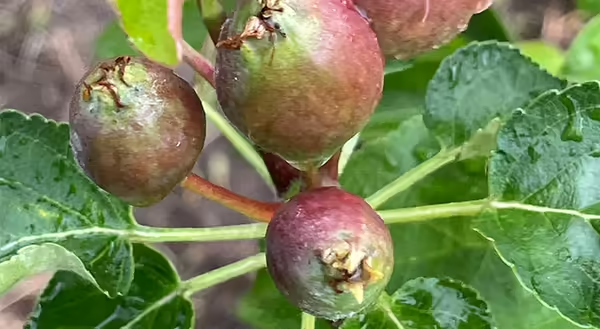
Chemical thinning is a crucial step in successful apple production that could be done in May to June, helping to manage fruit load, improve fruit size, and ensure consistent annual yields, especially on cultivars with biennial bearing tendencies. With several options available, selecting the right thinner and timing is going to be essential for good results this season. One of the concerns I saw last year in visiting orchards in Northern Illinois was a need for chemical thinning, a need that resulted in this topic covered by Dr. Amaya Atucha at our Stateline Fruit and Vegetable Growers Conference in Rockford this year. As I’ve gotten some calls this year about chemical thinning, this is a good time to revisit this orchard action.
Please note that the Midwest Fruit Pest Management Guide covers your options, rates, and timing, beginning on page 44.
- Sevin is considered a mild, reliable thinner. The XLR+ formulation is preferred for better pollinator safety and effectiveness, especially when paired with other thinners like NAA.
- NAA (e.g., Fruitone, Pomaxa, Refine) is among the most potent thinning agents and is highly temperature-sensitive—overthinning is more likely above 85°F. It’s particularly useful in promoting return bloom in varieties like ‘Honeycrisp.’
- NAD (Amid-Thin) is less aggressive than NAA and a good option when seeking gentler results. It’s often used at petal fall.
- 6-BA (Maxcel, Exilis 9.5 SC) works best in warm weather (65°F+), improving fruit size and offering mild thinning. It can be especially effective when used early.
- Promalin is generally reserved for mature trees and best applied at King bloom. Like others, it performs better under warm conditions.
- ACC (also known as Accede) is used in the King Bloom and Post Bloom period. This option can be used beyond what other chemical thinners have been traditionally used, near and even beyond 15 mm fruitlet size. More research is being done on this chemical thinner.
Timing of chemical thinners:
Early bloom thinning can be effective for varieties prone to biennial bearing. Options like liquid lime sulfur and ATS target flower parts directly but could cause leaf damage or affect fruit finish. You should use the pollen tube growth model to keep damage from occurring, especially with liquid lime sulfur. For both Southern and Central Illinois growers- even Northern Illinois ones- it may be too late to apply it this year based on the fruit development.
At petal fall (fruits at 5-6 MM) there is very little risk of over thinning because fruits tend to not be as sensitive to thinners. You need 8 hours with no rain after the thinning spray for some. Combinations like Sevin + Maxcel or NAA are effective when temperatures are warm.
Your next two periods, petal fall (fruits at 7-15 MM) and (fruits at 16-20 MM), could be further options if you have found that the crop load is still heavy for the future. In these periods, we would recommend using carbohydrate models (NEWA) and other tools to measure the impact that chemical thinning could have.
Some best practices:
- Good return bloom usually can be assured if fruit density is reduced to 8 to 10 fruit per cm of limb circumference within four weeks of bloom.
- To reduce degree of thinning or avoid over thinning, reduce the concentration (but not the amount) per tree.
- Weather plays a big role in the efficacy of chemical thinners. Conditions like applying after frost or freeze events can be risky. Thinners are less effective after warm, dry periods and more effective after cool, moist periods. Warm temperatures may also need to be achieved.
- Chemical thinners are most effective on low vigor trees, trees with light pruning, trees with heavy bloom, poor pollination, and/or poor air drainage.
- Some of the chemical thinner application rates will vary from apple cultivar to cultivar as you see in that Midwest Production Guide chart.